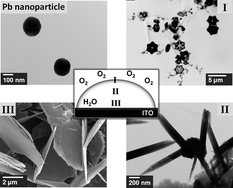Autonomous interfacial creation of nanostructured lead oxide†
Abstract
We first established a process for the autonomous creation of PbO

* Corresponding authors
a
Electrochemical Reaction and Technology Laboratory (ERTL), School of Environmental Science and Engineering, Gwangju, South Korea
E-mail:
jaeyoung@gist.ac.kr
Fax: +82-62-715-2434
b Ertl Center for Electrochemistry and Catalysis, Gwangju Institute of Science and Technology, Gwangju, South Korea
c Department of Chemistry, Kyungpook National University, Daegu, South Korea
We first established a process for the autonomous creation of PbO

 Please wait while we load your content...
Something went wrong. Try again?
Please wait while we load your content...
Something went wrong. Try again?
Y. Kwon, H. Lee and J. Lee, Nanoscale, 2011, 3, 4984 DOI: 10.1039/C1NR10603A
To request permission to reproduce material from this article, please go to the Copyright Clearance Center request page.
If you are an author contributing to an RSC publication, you do not need to request permission provided correct acknowledgement is given.
If you are the author of this article, you do not need to request permission to reproduce figures and diagrams provided correct acknowledgement is given. If you want to reproduce the whole article in a third-party publication (excluding your thesis/dissertation for which permission is not required) please go to the Copyright Clearance Center request page.
Read more about how to correctly acknowledge RSC content.
 Fetching data from CrossRef.
Fetching data from CrossRef.
This may take some time to load.
Loading related content
